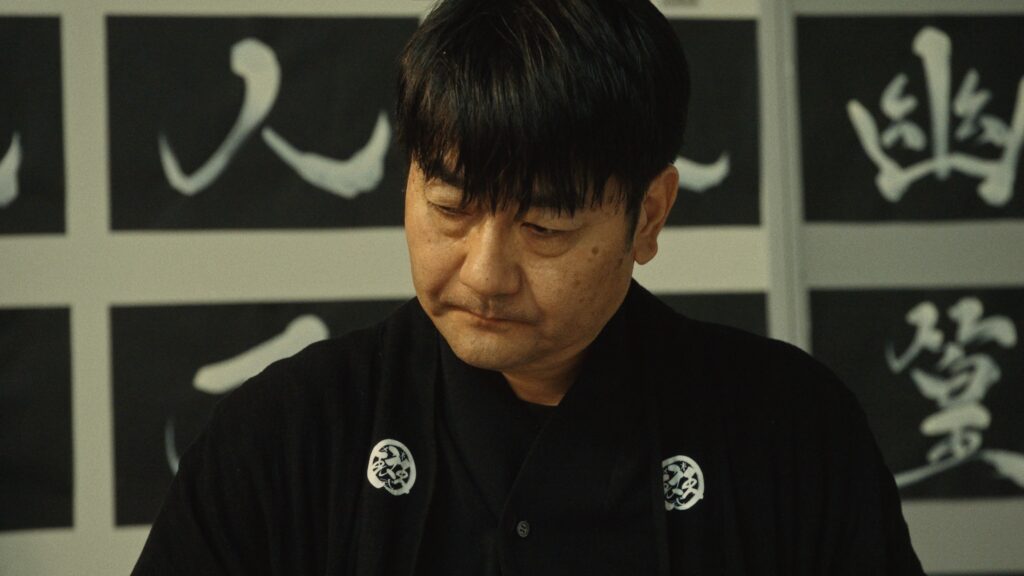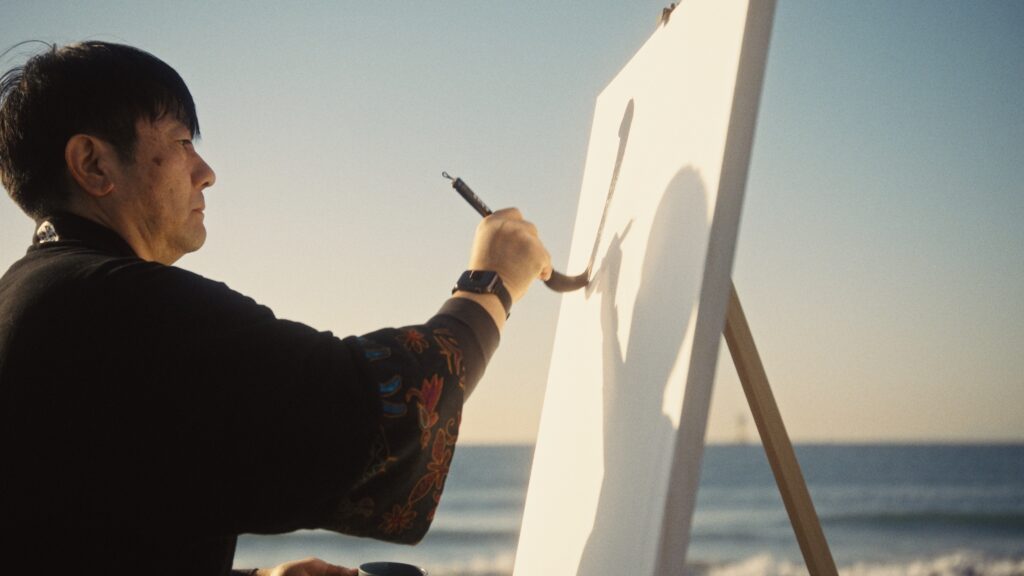
Pen name: Madara (MADARA)
- Real Name: I refrain from disclosing my real name in order to focus on my work and concepts.
- Date of birth: May 6, 1972, Fukushima Prefecture, Japan
Timeline of MADARA (斑)
1972
Born in Minamisoma City (former Haramachi City), Fukushima Prefecture, Japan.
Began drawing daily from infancy, according to his mother.
1975
Created sketches and imaginative drawings. Parents framed and displayed his works at home.
1977
Entered a calligraphy school led by a master of the Japan Calligraphy Federation and began formal calligraphy training.
1978
Entered kindergarten. Spent most days drawing independently and displaying his own works at the back of the classroom.
1979–1984 (Elementary School Years)
Frequently submitted artworks to school and regional exhibitions.
Received awards almost every month; accumulated more than 50 prizes during six years.
(All certificates were later lost in a house fire.)
1985–1987 (Junior High School Years)
Art and calligraphy pieces were selected for major exhibitions in the Kanto region and received special prizes.
Received over 30 awards during three years.
(All certificates were lost in the later house fire.)
1987
Achieved 8-dan, the highest calligraphy ranking at the time. Continued independent study.
1988–1990 (High School Years)
Created artworks, calligraphy, and 3D model pieces; some were published in magazines.
Designed a photorealistic class flag using an airbrush. The work attracted the attention of the city mayor and was later presented to him.
1991 (Art School Period)
Applied to Tama Art University but was not accepted. Entered Tohoku Bunka Gakuen University, majoring in design.
Continued selling works to private collectors.
1994
Employed as a design planner at a design furniture company in Sendai, Miyagi Prefecture.
Continued periodic sales to collectors.
1995
Returned to his hometown to support his family’s business.
Established an at-home atelier and resumed producing artworks.
Formed an indie pop band as a drummer; engaged in live performances and released singles and albums while serving as creative and recording director.
1998
Expanded the family business and launched a retail brand. Responsible for design and branding.
Started selling products utilizing calligraphy techniques.
Met his future spouse.
Temporarily suspended sales to collectors to focus on business.
1999
Opened a second store; led design and branding.
Built an online shop and launched e-commerce operations.
Produced TV commercials and appeared on media programs.
Married; used his artworks for wedding design elements.
2000
Opened a third store; managed design and branding.
Created a child-themed artwork for store signage.
Discovered graphology, leading to the development of his own calligraphy method, Hisseki-jutsu. At the time, no calligraphers had integrated it into calligraphy practice online.
2002
Began working with an application development company, commissioning inventory and order management systems (later joined the company).
Produced design concepts, packaging, and store visuals.
2003
Expanded into major e-commerce platforms including Rakuten, Yahoo!, Bidders, and Excite.
Relocated and renewed the first store.
Adopted the artist name “Tsuki-kaze.”
2004
Calligraphy-based product orders reached 400 per day.
Produced 20,000–30,000 naming certificates monthly.
First son was born.
Expanded home atelier and continued producing drawings and calligraphy.
2005
Received Rakuten’s Shop of the Year Award.
Calligraphy-based product was documented on Wikipedia as a first in Japan.
Advanced UI design consistency for the online store.
2006
Opened a fourth store.
Selected as a representative member during the establishment of Rakuten’s “Super Auction,” joining discussions with CEO Hiroshi Mikitani.
2007
Products featured on national TV programs including TV Asahi’s “Ame-talk!” and Fuji TV’s “Mezamashi TV.”
2008
Daughter was born.
Began creating large-scale artworks inspired by her birth.
2009
A meteorite-triggered fire destroyed his house and atelier. All artworks and documents were lost.
2010
Began coverage by the TV program “Himitsu no Kenmin SHOW.”
Started rebuilding his home and atelier.
2011 — Great East Japan Earthquake
February: TV broadcast caused overwhelming demand, filling orders for over six months.
March 11: Experienced the Great East Japan Earthquake and nuclear disaster; became unable to return home.
Spent six months searching for missing family members.
Relocated to Fukushima City and began rebuilding the factory and store.
Atelier reconstruction was abandoned due to disaster conditions.
2012
Opened a fifth store; responsible for design and branding.
Temporarily stopped artistic production due to PTSD from the disaster.
2014
Relocated and opened a new main factory; oversaw its design.
Rebuilt an atelier at home and resumed creative work.
Learned that a long-time collector had died in the tsunami.
2015
Opened a sixth and seventh store.
Began producing three-dimensional works in the atelier.
Struggled creatively due to psychological effects of the earthquake, tsunami, and nuclear accident.
2016
Opened an eighth and ninth store.
Produced videos of three-dimensional works and published them on YouTube and Instagram.
2017
Opened a tenth and eleventh store.
Attempted to resume painting and calligraphy, but persistent imagery of death led to repeated disposal of works.
2019
Family business collapsed following the termination of TEPCO’s corporate compensation program.
Research for compensation documents revealed that he had produced approximately 800,000 calligraphy pieces over 20 years, including naming certificates for nearly 800,000 people.
Moved to Kanagawa Prefecture and joined the application development company, working in UI/UX design and SEO.
2023
While serving as a director of the development company, founded Crafort Inc. to pursue artistic creation and sales.
Established an atelier in Matsuda Town, Kanagawa Prefecture.
Launched the apparel brand “KANJI TOKYO.”
2024
Reframed all past experiences as integral to his identity and adopted the artist name “MADARA,” meaning a mixture of diverse colors.
2025
Registered as an artist with a French art gallery and began international sales.
Launched calligraphy workshops and B2B production services.
Opened an artist gallery on Singulart.
Present
Continues artistic creation and global outreach as MADARA.
history
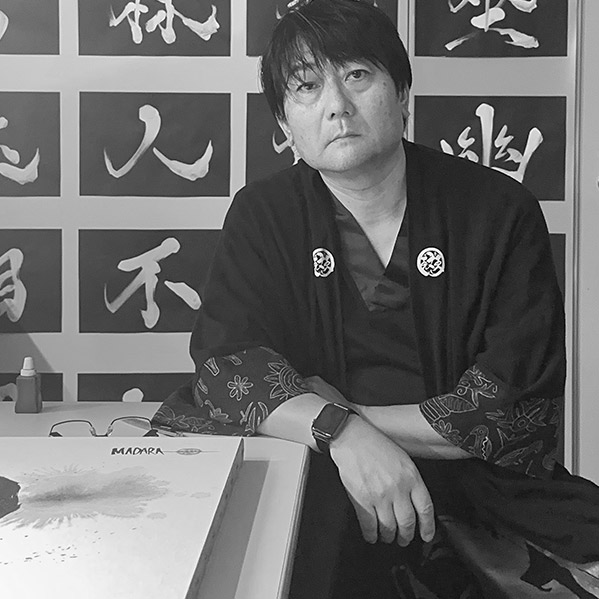

Madara is a Singulart artist and has a gallery.
Artist Statement
by MADARA
I do not simply write with the brush
I reflect the heart through it.
Calligraphy is not a technique of writing characters.
The sinking of ink, the trembling of vermilion, the breath of the brush
each movement lives and feels alongside human emotion.
While I deeply respect the ancient path of calligraphy,
I do not confine myself within its traditional frame.
Through my work, I breathe new life into it
infusing the brush with the emotions and prayers of our time.
To me, calligraphy is a form of dialogue beyond words.
Within each stroke live love, solitude, hope, forgiveness
and sometimes, even pain.
A line, like the human heart, never flows perfectly straight;
it quivers, leaps, and sometimes bleeds.
Yet, it is precisely within those tremors
that life reveals its true presence.
Through my practice of Hisseki-jutsu the Art of Sacred Brushstrokes
I imbue each work with prayer and the energy of fortune.
Calligraphy, to me, is not merely the creation of beauty,
but an invocation of power within the viewer’s soul.
The colors that flow from my brush are both passion and healing
a faint light kindled within the stillness of the night,
a symbol of the quiet warmth dwelling in every heart.
Calligraphy is not the act of drawing lines,
but of binding hearts together.
Upon the paper, I inscribe love, connecting people and the world itself.
Even if it takes countless attempts,
repainting, rebuilding the canvas, rewriting again and again
every moment of that process is a prayer,
a discipline, and an act of creation.
All those colors mingling and layered
form the very essence of who I am:
MADARA, the one born from the beauty of imperfection.
I am a calligrapher.
I am an artist.
I live through technique, and return to the heart.
Like colors dwelling in silence,
I continue to take up the brush and paint love.
The background of calligraphy artist MADARA
MADARA is a master of Japanese calligraphy, the traditional Japanese art of calligraphy. They started practicing it at the age of five. With guidance from a certified master of the All Japan Calligraphy Federation, MADARA improved their skills in this ancient and important art. As a young artist, they joined many exhibitions and competitions, won awards, and gained recognition for their great talent.
In 2000, when MADARA was 28 years old, they discovered Hisseki-gaku ( Graphology ). This is the scientific study of handwriting to understand personality, relationships, and behavior. MADARA became very interested in Hisseki-jutsu, a method that helps people change their luck by adjusting how they write.
MADARA saw a way to connect this method with the beauty and spirit of Japanese calligraphy. They started creating a new kind of art that combines tradition with new ideas. By using Hisseki-jutsu in Japanese calligraphy, MADARA expanded the meaning of Japanese calligraphy and gave it a new purpose.
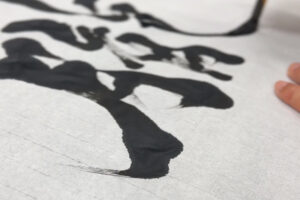
The Unique Art of Hisseki-jutsu Calligraphy( ” Hisseki-jutsu Shodo ” in Japanese)
Hisseki-jutsu is more than just a handwriting technique. It is a special practice from Japan that helps improve different aspects of life, such as health, wealth, success, and talent. By carefully shaping characters with these goals in mind, Hisseki-jutsu helps people bring these positive qualities into their lives.
MADARA applied this method to writing personal names, leading to the creation of ” naming art “—a form of Japanese calligraphy used to design name plaques for newborns in Japan. These plaques are believed to bring good fortune to a child’s future and became very popular. At the peak of demand, MADARA received up to 400 orders a day, creating over 800,000 name artworks over 18 years.
As the only Japanese calligraphy artist in Japan to master both traditional calligraphy and Hisseki-jutsu, MADARA’s skills are truly unique. Today, MADARA works as the Japanese calligraphy artist for KANJI TOKYO, creating custom artworks filled with wishes for success, happiness, and prosperity. Each piece—whether a name or a meaningful word—is carefully crafted, blending the beauty of Japanese calligraphy with the power of Hisseki-jutsu.

MADARA’s art is more than just something beautiful to look at. It is a meaningful expression of hope and positivity, deeply connected to Japanese tradition.
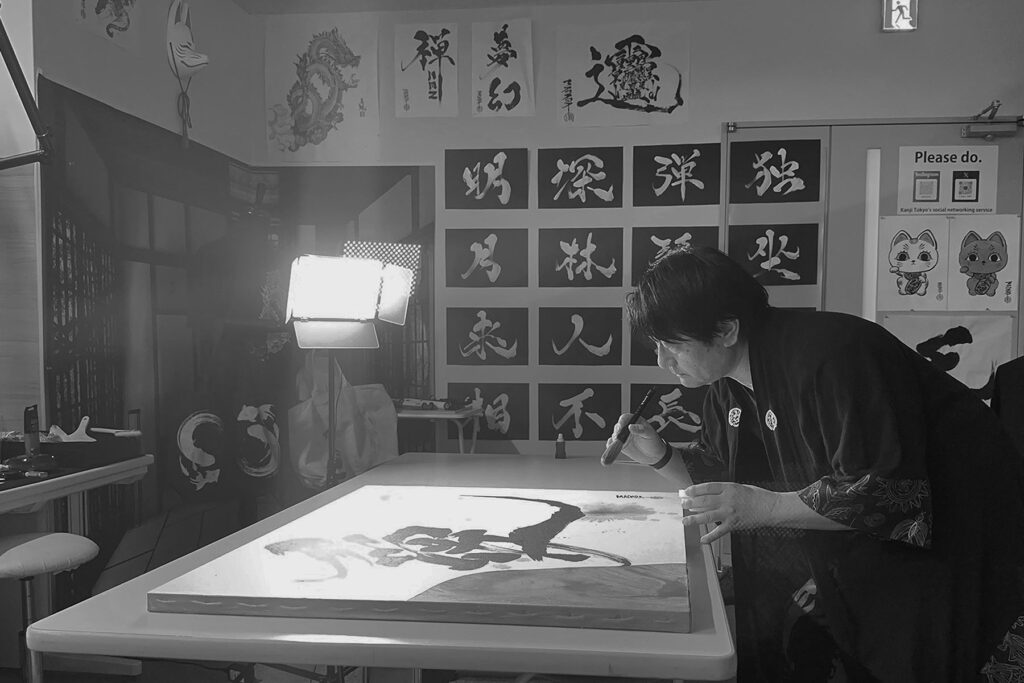
Find out more about the thoughts of calligraphy artist Madara
Artistic background and how to become an artist
My mother told me that from the time I was one year old, I was constantly doodling with crayons. My mother always provided me with art supplies and paper, so I grew up drawing every day. At the age of five, I began training in the traditional Japanese art of calligraphy under a master from the All Japan Calligraphy Federation, and my talent for it was evident from an early age. As a boy, I always won awards and received high praise whenever I exhibited my work at art shows and exhibitions. At the age of 15, I qualified as a calligraphy master, and since then, I have pursued my own unique path as a calligrapher, adopting the pen name “月颯(TSUKIKAZE)”
In 2000, at the age of 28, I discovered graphology, a study that analyzes personality, compatibility, and lifestyle traits based on the way characters are written. I was particularly drawn to the art of graphology, which suggests that changing one’s writing style can improve one’s future fortunes. I studied this technique in depth, incorporating it into my own calligraphy, pursuing new forms of expression and establishing Hisseki-jutsu calligraphy. Hisseki-jutsu calligraphy is a style of calligraphy that expresses prayers and wishes for people’s happiness.
In 2002, I began using Hisseki-jutsu calligraphy to write names on “Issho Mochi,” a traditional Japanese rice cake sold at the company where I was working at the time, with the hope that the child would grow up to be a wonderful person. This product became a huge hit, spawning numerous companies selling similar products. Over the course of 20 years, I sold 800,000 of these products, meaning I wrote the names of 800,000 people using Hisseki-jutsu calligraphy.
However, while living in Fukushima, he lost 24 family members and relatives in the Great East Japan Earthquake of 2011. Furthermore, due to the nuclear power plant explosion, both his company and his home were off-limits. However, he managed to move and restart his business, hoping to continue running his one-sho rice cake shop. However, in 2018, the compensation standards were changed, and even losses resulting from the nuclear power plant accident were no longer covered. As a result, the company he worked for went bankrupt. He then moved to Kanagawa Prefecture, where he practiced calligraphy as a hobby, and in 2023 he started a business selling calligraphy-based products and activities.
When I started the business, I changed my pen name from “月颯(TSUKIKAZE)” to “斑(MADARA)” which means a mixture of various things, and I currently work as a Hisseki-Jutsu calligraphy artist named MADARA.

Exploring themes and concepts in art
Love has always been at the heart of my art. After the Great East Japan Earthquake, I lost loved ones, suffered and worried, and hoped to bounce back at work, but to no avail. It was my friends who helped me through it, and my wife who always kept me strong. I couldn’t help but feel a sense of nostalgia. I believe that this love goes beyond personal affection; it connects people, countries, and cultures to a “love of the world.” There are still countries in the world suffering from war and conflict. I believe that if we could feel even a little compassion for others, perhaps the trigger for war would not be pulled. Through the traditional Japanese art of calligraphy, I hope to express universal emotions and wishes deep within, creating works that quietly but truly resonate with the viewer.
… These thoughts have built up, and I have begun to explore the new realm of “contemporary calligraphy art.” I believe that by combining the strength, serenity, and spirituality of traditional calligraphy with painterly beauty, color, and decorativeness, I can create expressions that resonate intuitively with more people. I attempt to imbue my work with a “living heart” not only in the shape of the characters, but also in the white space, color, and composition itself. I write with the desire to transcend the mere act of “writing characters” and convey a “story” and “emotion” that viewers can feel in their hearts through the entire work.
To me, calligraphy is not simply the inheritance of traditional culture, but a “living art” that opens up new possibilities in the modern era. This is why I call my work “contemporary calligraphy art.” It is not an extension of the classics, but a new artistic realm that resonates with the sensibilities of people living today. I believe that when these two blend together, the strength dwelling in the lines of calligraphy and the richness of the colors of painting, an “energy of love” emerges that cannot be expressed in words.
My challenge has only just begun. However, I hope that this art, which spreads the theme of love to the world, will transcend borders and become a catalyst for connecting people’s hearts. Calligraphy art is my own prayer and challenge to give form to love for the world. I will continue to put these feelings into my works, one brush at a time.
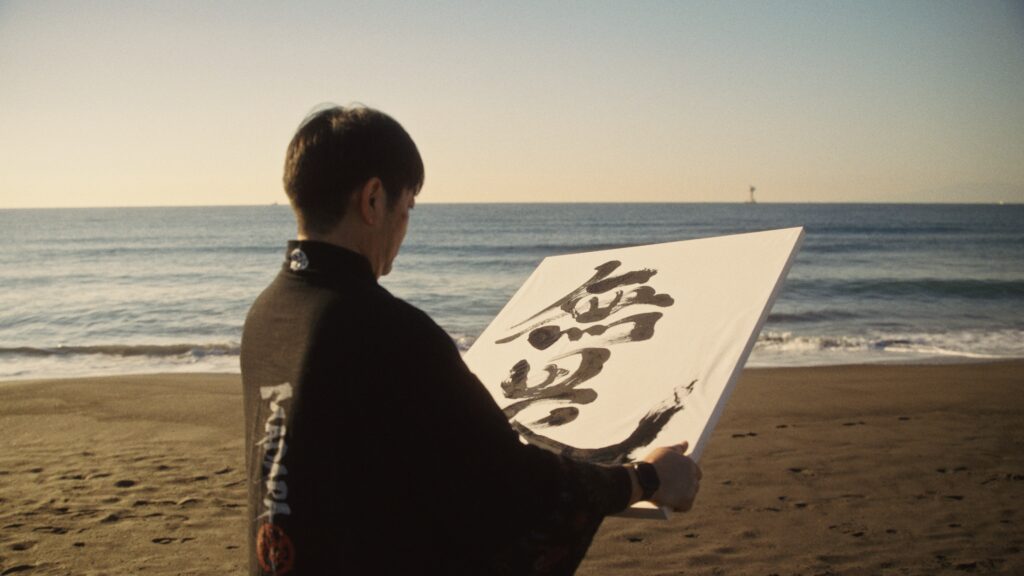
Artistic styles and techniques
My artistic style is a unique expression that could be called “contemporary calligraphy art,” a fusion of my own uniquely developed Hisseki-jutsu calligraphy and painting.
Unlike traditional calligraphy, which simply pursues the beauty and perfect form of characters, I view characters as living forms. I create works that visually convey the meaning and emotion inherent in the characters by varying the strength of the lines, white space, the shades of ink, and even combining color and pictorial elements.
In my works, I pay particular attention to the brushstrokes, the amount of pressure, and the variations in the shades of ink and paint. For example, a single line is not simply something that has been drawn; it is in harmony with my breathing, my state of mind, and the rhythm of the entire work. I believe that lines, which are the foundation of calligraphy, give the entire work a sense of life, as if breathing, and allow the characters themselves to resonate with the viewer. The pictorial elements that adorn those lines serve to convey the meaning of the characters and the theme of the work more intuitively and sensually.
The use of white space is also an important feature of my style. Incorporating the Zen concept of “ma” (space), I am conscious of the space in which each character and color exists, breathing. The white space is not simply blank; it gives the work depth and serenity, and allows the viewer room to freely add their own emotions. This transforms the work into dynamic, interactive art that evokes unique experiences and interpretations for each viewer.
In terms of technique, I build upon traditional calligraphic techniques such as brushstrokes and ink shading, while incorporating painterly techniques such as color gradations, color mixing, and texture expression. This allows my works to transcend mere letters, creating a three-dimensional, visual world centered around the characters. Furthermore, when creating large-scale works, I vary the speed and pressure of my brushstrokes to simultaneously express the power unique to calligraphy and the rhythmic quality of painting.
My style is characterized by respecting tradition while integrating it with a modern sensibility, not bound by existing frameworks. Characters are a medium that not only convey meaning, but also speak directly to the human heart through the energy of their shapes and lines. To maximize this power, I utilize the techniques of both calligraphy and painting, aiming to create works that allow the viewer to directly experience emotions and ideas.
As a result, my works are completed as “modern calligraphy art,” in which the beauty of the characters, the richness of color, and the tranquility of the white space coexist. This is art that allows the viewer to interact with the work and discover meaning within themselves, and it is the core of my style.
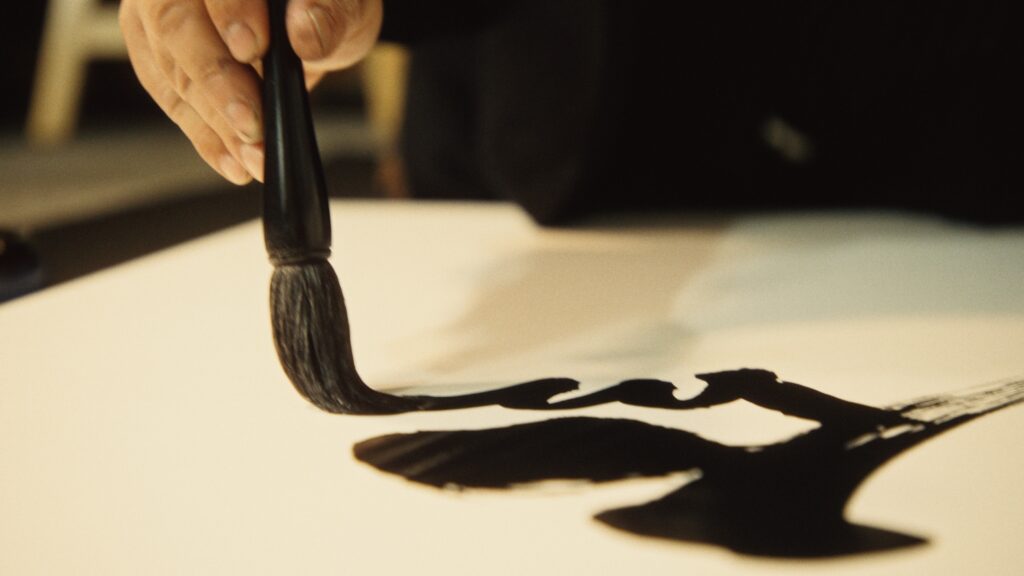
What is your driving force and inspiration for creating this work? What do you want to convey through your work?
The driving force behind my work comes from the beauty and emotions present in various moments of everyday life. When I come into contact with words or sounds, when I sense the vastness of the world or the grandeur of the universe, when I am moved by the kindness and compassion of others—these moments are the great energy that drives my brush. In particular, when I experience someone’s smile or kindness, the breath of nature, or the depth of culture, I feel a strong desire to express in my work something that resonates deep within me. These moments may pass in an instant, but for me they are a source of inspiration that lasts. I want to give them form and display them.
When expressing myself through calligraphy, I do not simply paint letters or shapes; I incorporate the rhythm of my heart, thoughts, and emotions. By combining the shades of ink, the movement of the brush, the momentum of the lines, the use of white space, and in some cases, color and decorative elements, I aim to create a sensory experience that goes beyond the written word. Each line reflects my own breathing and state of mind, and I hope that when viewers come face to face with my work, it will resonate with them in their own hearts.
Through my works, I wish to convey the various emotions surrounding “love.” Compassion, impermanence, eternity, singleness, and eternal love—these are all universal themes that connect people to each other, and to the world. Life changes from moment to moment, and joy and sorrow pass, but the power of love transcends race, transcends time and space, and remains in our hearts, connecting us to the next moment and the next generation. The characters and shapes I create with my brush are intended to be more than just visually beautiful; they also bring warmth, hope, and quiet peace to the hearts of those who see them. And that is what I hope to achieve.
Furthermore, my style of “contemporary calligraphy art,” which combines calligraphy and painting, is also a means of expression that allows me to more intuitively convey my emotions and thoughts. By expressing the innermost movements of the heart and the energy of love, which cannot be conveyed through words alone, in three dimensions through color, composition, and white space, I aim for my works to become a forum for dialogue with the viewer. My hope is that this resonance, created through words, shapes, lines, and colors, will connect with the viewer’s own sense of love and compassion, bringing small realizations and joy to their daily lives.
My inspiration is fleeting, yet it takes on a lasting form through my works. I put my wishes into each and every stroke and send a message of love to the world. And I think of your happiness. This is my mission in art and the source of my passion. My works are my heart itself, and they are only complete when they resonate with the hearts of those who view them. My driving force and the greatest joy of creating is to convey compassion, hope, and everlasting love to people’s hearts through calligraphy art.
